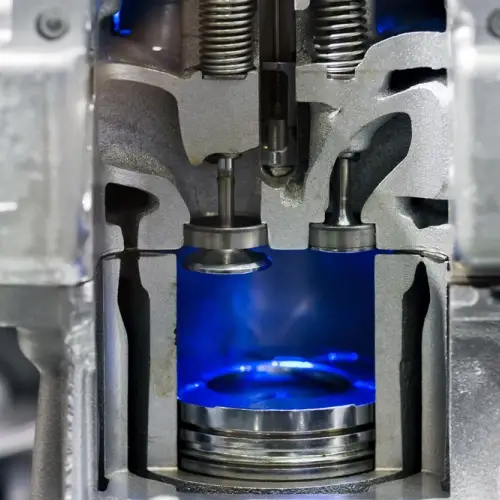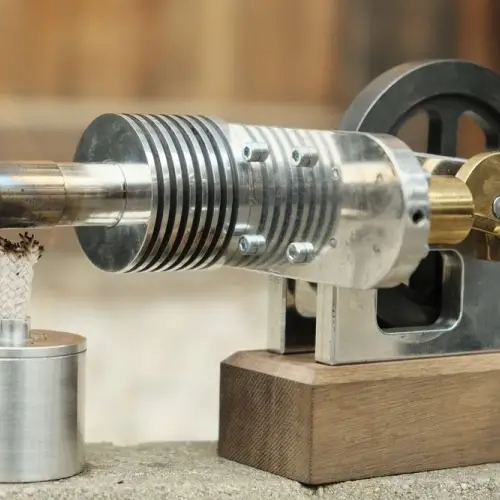
An adiabatic process is a thermodynamic process in which a system does not exchange heat with its surroundings. This means that the heat entering or leaving the system is zero; that is, the change in the system's internal energy is due solely to the work done on or by it.
The term "adiabatic" refers to those elements or conditions that prevent heat exchange with the environment, such as an adiabatic wall that does not allow heat transfer.
The assumption that a process is adiabatic is often used as a simplifying approximation in many thermodynamic analyses, as it facilitates calculations. However, in practice, perfectly adiabatic systems do not exist, although they can be approximated in many cases.
The concept of an adiabatic process is fundamental to understanding and applying the first law of thermodynamics, as it establishes the relationship between heat, work, and the internal energy of a system in the absence of heat transfer.
Examples of adiabatic processes
Below are some examples of adiabatic processes in different thermodynamic systems:
Expansion and compression in a cylinder with gas
 In an internal combustion engine, the air-fuel mixture is compressed adiabatically as the piston moves upward in the cylinder.
In an internal combustion engine, the air-fuel mixture is compressed adiabatically as the piston moves upward in the cylinder.
This compression process increases the temperature of the gas due to rapid compression without heat loss to the surroundings. At the end of the cycle, when the piston moves downward, the gas expands adiabatically, performing work on the piston without exchanging heat with the surroundings.
Gas flow through a nozzle (de Laval nozzle)
In a jet engine, exhaust gases are accelerated as they pass through a nozzle, causing adiabatic expansion.
During this process, the gas expands rapidly, increasing its volume and reducing its pressure, without exchanging heat with the surroundings. The gas's internal energy is converted into kinetic energy, allowing it to accelerate to high speeds, generating the thrust needed to propel the aircraft.
Descent of air in the atmosphere (adiabatic heating)
When an air mass descends into the atmosphere, as occurs in meteorological phenomena such as the foehn or chinook, the air is compressed adiabatically.
This process causes the air temperature to rise without any heat transfer from the surroundings.
This type of warming contributes to the formation of warm winds that affect mountainous regions and to the prediction of climatic phenomena.
Refrigerators and air conditioning systems
In a refrigeration system, such as air conditioning, the refrigerant gas undergoes adiabatic expansion as it passes through the expansion valve.
In this process, the pressure and temperature of the gas decrease rapidly without exchanging heat with the surroundings.
Sound production in gases
Sound waves travel through air through adiabatic processes. As the sound wave travels, air particles rapidly compress and expand, without time for significant heat exchange to occur.
Expansion of a helium balloon
When helium gas is released into a balloon, the gas expands adiabatically. If the balloon rises into the atmosphere, the helium expands without exchanging heat with the surroundings, as the process is very rapid.
The adiabatic expansion of helium in the balloon reduces its pressure and temperature, allowing it to ascend.
Air compression in an air compressor
In an air compressor, air is compressed adiabatically when it is introduced into a smaller volume. This process raises the air temperature without allowing heat to dissipate into the environment, causing the air to heat up considerably.
The energy used to compress air increases its internal energy, which can later be used in applications such as the power of pneumatic tools or in refrigeration systems.
Piston in a Stirling engine
 In a Stirling engine, the gas inside the cylinders expands adiabatically during the power phase. As the gas expands, work is done on the piston, but no heat is exchanged with the surroundings.
In a Stirling engine, the gas inside the cylinders expands adiabatically during the power phase. As the gas expands, work is done on the piston, but no heat is exchanged with the surroundings.
This type of engine takes advantage of temperature variations in an adiabatic cycle to efficiently generate energy, although additional mechanisms are required for heat exchange in other phases of the cycle.
Related concepts
-
An isentropic process is an adiabatic process that is also reversible. In this case, the system also maintains constant entropy, making it an ideal process for various engineering applications.
-
An adiabatic wall is one that prevents heat transfer between the system and its surroundings. In practice, an insulated wall can approximate the conditions of an adiabatic wall, although not perfectly.
-
An adiabatic system is one in which heat exchange with the outside world is not permitted. This concept is key in the modeling of various thermodynamic processes and is commonly used in engineering and physics.
Adiabatic heating and cooling
Adiabatic compression of a gas causes an increase in temperature. It also increases the gas's internal energy. Adiabatic expansion causes a decrease in temperature.
In both processes, the energy of the system remains constant. There is neither an increase nor a loss of heat. In contrast, free expansion is an isothermal process for an ideal gas.
Such temperature changes can be quantified using:
- The ideal gas law.
- The hydrostatic equation for atmospheric processes.
Adiabatic heating occurs when the pressure of a gas increases due to the work done on it by its surroundings.
Adiabatic cooling occurs when the pressure on an adiabatically isolated system decreases. This decrease allows it to expand. As the volume increases, its temperature and internal energy decrease.